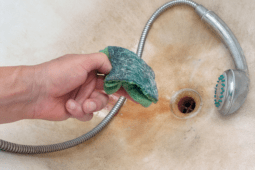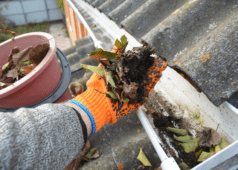How to Kill Weeds in Your Lawn Without Using Chemicals
Weeds are the immediate eyesore in your lawn, especially when they start growing out of control. They can destroy the natural beauty of your turf. They even keep your plants and grass from growing healthy as they absorb nutrients and moisture intended for your plants. Knowing how to kill weeds in your lawn is a life hack that every homeowner needs to know.
Many of us tend to resort to chemicals and herbicides to keep these unwanted weeds from multiplying. But did you know that there are more natural ways of getting rid of weeds? When we first moved into our home the entire lawn had been overtaken by weeds and overgrowth (and some other unique versions of garden decor). Our first order of business was cleaning up the lawn so it could be livable but didn’t want to use unnatural chemical methods.

So, we decided to go the natural, DIY route to remove weeds from our lawn and the results were definitely worth it! This article will teach you tricks on how to kill weeds in your lawn the natural way. And if natural can’t do the trick, then it’s the only time for you to check out those store-bought herbicides.
Types of Weeds
Identifying the weeds you have in your garden plays a crucial role in how to manage them properly. Basically, you can find three different types of weeds on your lawn.
Broadleaf Weeds
You can distinguish broadleaf weeds because they have leaves that are broad and flat. The most common examples of this type of weeds are dandelion, plantain, thistle, and clover.
Grassy Weeds
Grassy weeds are called such because they have leaves that resemble grass blades. It can be divided into two subtypes: perennial grassy weeds and annual grassy weeds.
The perennial grassy weeds do not grow during winter, but emerge at springtime. These weeds germinate through roots and seeds. An example of perennial grassy weeds is quack grass.
The annual grassy weeds, on the other hand, die at the end of their growing season, but not before reseeding. Once the next spring comes, the seeds from the dead weeds will start to develop into new weeds.
Grass-Like Weeds
Grass-like weeds are often mistaken as grassy weeds. However, the leaves of these weeds are actually tube-like or triangular upon closer inspection. The leaves are also hollow as opposed to the flat grass blades of the grassy weeds. Some examples of grass-like weeds are wild garlic, wild onion and nutgrass (nutsedge.)
Natural Ways to Kill Weeds
Once you identify the weeds pestering your garden, the next thing to do is to get rid of them. But how? Here are the different ways on how to kill weeds in lawn using natural means.
Do It Organically
You can find many weed killers in your home. Though using homemade herbicides may require more time and effort than using store-bought chemicals, these home herbicides are the safest for the other plants surrounding the weeds, as well as your grass.
Vinegars have the power to kill plants due to their acidity. However, make sure that it contains 5% acetic acid or more. According to a study cited by USDA, 5-10% of concentrations can kill weeds in the first couple of weeks of their life. Meanwhile, you may require a higher level of vinegar concentrations for older weeds. Simply spray the vinegar directly on the weeds to get rid of them.
Hot boiling water is also another trick you can use. Boil water to at least 200°F, and pour directly over weeds. This weed control strategy works best for weeds growing in between your pavement stones and gravel.
Some other techniques used by other people include dish soap, apple cider vinegar and Epsom salt.
RELATED: Try our DIY Weed Remover that actually works
Do It Manually

How to kill weeds in lawn naturally includes getting your hands dirty. If the weeds in your garden are still manageable in size, then the best way is hand-weeding. Dig them out manually using your bare hands and a garden tool.
This method works best against young broadleaf weeds. When weeds have matured, they already have deep roots that may be hard to pull. To remove a weed, push a dandelion digger or a sickle-blade in moist soil. Angle the tool in a way that it slants downward toward the center of the plant. Loosen the soil around the weed, and poke here and there while pulling the weed upward. Do this as carefully as you can without breaking the roots. Re-seed the bare spot with grass or any plant you want to prevent another weed from growing.
It is best to start manual weeding early in the spring before weeds start to grow. If new weeds start to grow on the same spot, pull them again and again until they starve themselves and eventually die.
Try a Flame Weeder
For those unfamiliar with what a flame weeder is, it is basically a long tube connected to a propane gas burner. It kills weeds using extreme heat through a controlled flame. A flame weeder does not directly kill the roots, but only the parts visible aboveground. Hence, you will need to re-flame the weeds several times in order to totally kill it.
How to Kill Weeds in Lawn Using Chemicals

Herbicides should always be the last resort. So if all of the natural ways fail, that’s the only time you have to use herbicides. By doing so, make sure that you follow the instructions carefully and you only target the weeds. Otherwise, it will damage other plants beside it and even ruin your flower beds and turf.
One important thing to take note of is to choose a herbicide that is safe for your turf. Not all chemical herbicides are the same. So you need to learn how to kill weeds in lawn properly if you are using these formulas.
Weed-and-Feed Products
Choosing the right weed-and-feed products is essential. Though it hits two birds in one stone of fertilizing the grass while killing the weeds, such a product is mostly harmful. If you do not use it correctly, you compromise the general well-being of your lawn. Additionally, the harmful chemicals used on these products can be taken indoors and harm you and your family too.
The safest weed-and-feed products are the ones made from corn gluten and organic fertilizer. But make sure that whatever product you use, you check on the instruction guide carefully. Follow the instructions as religiously as you can. Otherwise, you are risking the health of your lawn.
Pre-emergent Herbicides
Just as the name suggests, this type of herbicide kills seeds on their germinating stage. Before the weeds start to emerge from the soil, pre-emergent herbicides act fast and kill them to prevent sprouting.
Most pre-emergent herbicides are synthetic in nature. If you want to use it, start applying it before spring starts so that weeds are killed before the season. Some pre-emergent herbicides, however, need to be re-applied for several seasons before they actually take into effect.
Post-emergent Herbicides
If you’re too late to stop weeds from growing, you have to go for a post-emergence herbicide. This type of herbicide is used for already established weeds with deep roots. There are two sub-types for this kind of herbicide: contact and systemic. Both herbicides work differently, so make sure you check the label to get the correct herbicide for the effect that you want.
The contact post-emergent herbicide only kills the weed at a superficial level. It only kills the part of the weed it touches, leaving the roots safe and sound. This type of herbicide is fast-acting. You can definitely see the result quickly, and this is most useful when you deal with annual weeds.
On the contrary, the systemic post-emergent herbicide knows how to kill weeds in lawn from leaves to roots. It has the capacity to pass through the entire plant’s system to kill the roots and prevent further growth. However, this type of post-emergent herbicide requires repeated treatment to take effect. This is best for perennial weeds.
Takeaway


How to kill weeds in a lawn can be tricky, but that doesn’t mean that you cannot do it. It is best to try natural and organic ways of killing weeds whenever possible. You should resort to using chemicals only if all-natural ways do not succeed. Getting rid of the weeds will make your lawn more aesthetically pleasing. It will also allow plants and grass to grow healthy without competition. But before you actually kill those weeds, why not harvest them instead? Some weeds are actually beneficial to your health! Know your weeds, and you’ll find an easy removal.









